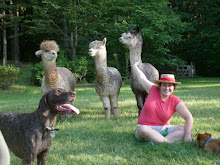Back in early November, my friend Laura Ohm and I went in on a pig together. No, not as a pet (though I did have a pet pig in college, ask me about that sometime), but as dinner. Many, many dinners. This is the second or third pig that Laura and I have split in as many years, and we go in on cows and lambs together too. If there's anything my 7 years as a vegetarian taught me, it's that I love eating meat but I do have a conscience. For me, buying animals directly from your farmer is a responsible and guilt-assuaging way to have your cake and eat it too. And don't think the cachet of pulling out, "yeah, I've still got about a third of a pig in my freezer" at parties doesn't rake in the men. It totally does.
Our 'season' for buying our animals is usually late fall. In brief, the life-cycle of our meat is such: we reserve a pig. Pig is born, weaned, raised and fattened. During this time, Laura and I frantically try to cook off the remains of last year's meat and also put in our cutting order for current, living pig. Farmer slaughters pig or hires a slaughterer to do the dirty work. Pig, who lived and grew on a small family farm and hopefully had a happy life, is slaughtered, then brought to a processor, where it is butchered and packaged. Laura and Robin pick up about 180 lbs of pig parts wrapped in butcher paper. Every year is a little different from the last. Sometimes we change farmers, sometimes the farmers change processors, sometimes the processors change their packaging. These variations may result in a pleasant surprise or niggling annoyance, like a new 'splitting' fee which is the equivalent of being charged for an extra plate for sharing at a restaurant. This year, along with 2 different cures for our hams (good) and the all of our ground pork seasoned as breakfast sausage (bad) our pig came with a heavy, double bagged pale lump of what we hoped was fat.

This weekend we decided to make lard. Lard is fat, but fat is not lard. Fat needs to be rendered, lipids melted, solids separated. Cobbling together our shared experience of rendering chicken and duck fat, we broke our fat down into manageable pieces and placed them in heavy enamel pots with just enough water to keep the fat moist before it melted.

then it cooked,

then it melted,

then it was done. It's so clear and pure, you can see your reflection though I don't really recommend doing this. It kind of felt I was giving myself a lard facial.

Now Laura and I each have a little over 2 quarts of solid lard and nearly the equivalent in delicious, deadly cracklings. Luckily, both byproducts are going to keep a long time in the fridge, even longer frozen. Which is good because there's only so much pork crackling you can nibble at for "research" at a time. Here is just one container of fresh, homemade lard, chilled overnight and still aromatic enough to pique Victor's interest.


No comments:
Post a Comment